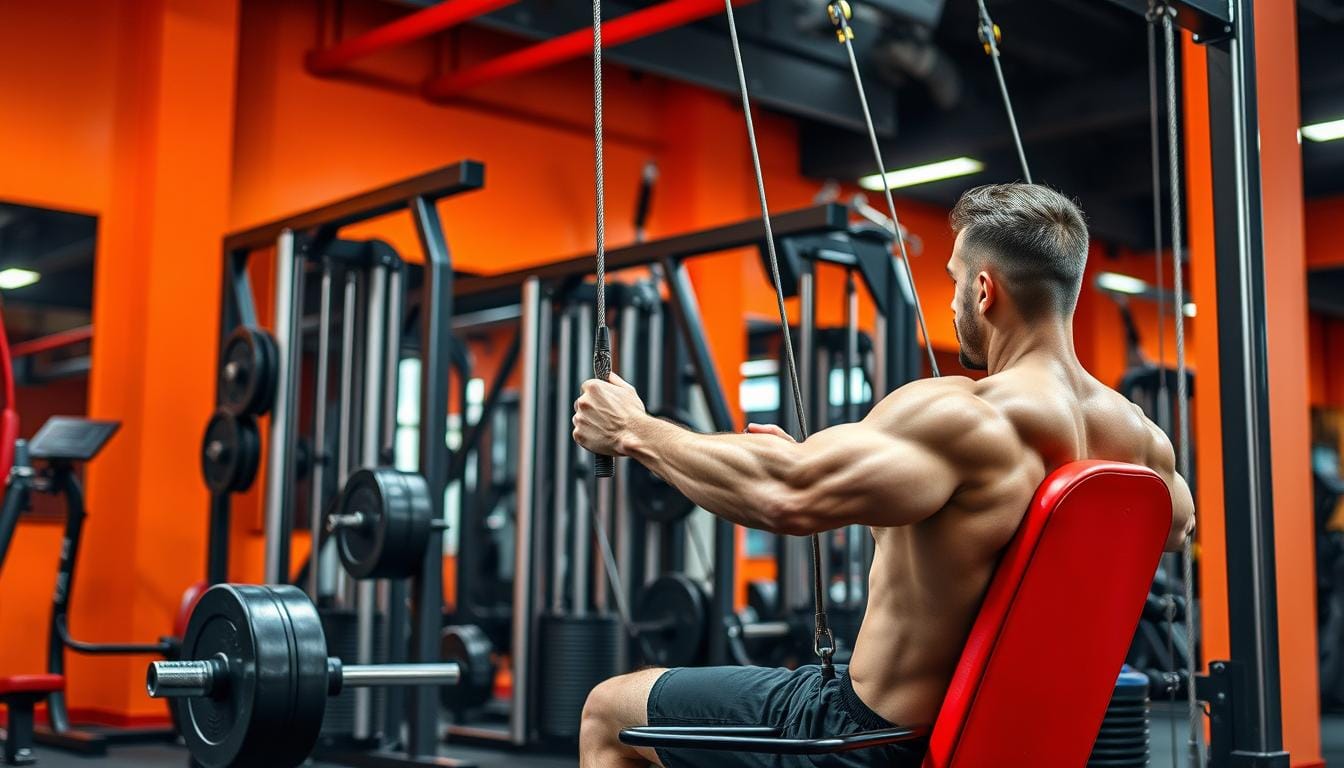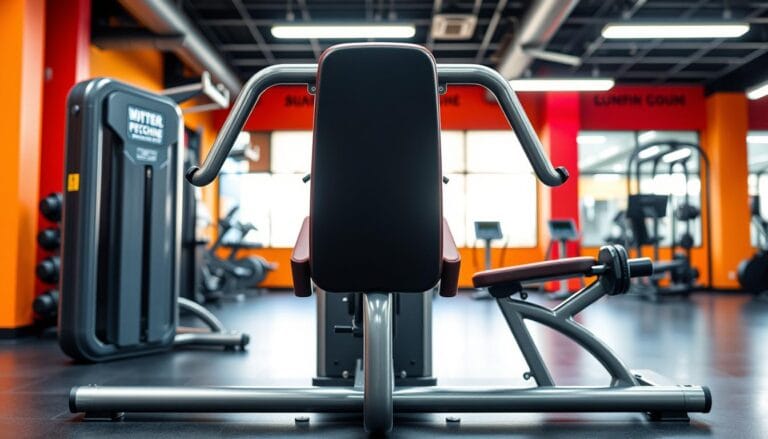Effective Cable Back Workouts
When I first went to the gym, my back workouts were tough. Free weights didn’t seem to help much, and I wasn’t getting stronger. But then I found cable back workouts, and everything changed.
Cable back exercises are different from free weights. They keep your muscles working hard all the time. You can do many exercises on one machine, making workouts more varied.
Cable machines are special because they let you move more than free weights. This means you can work your back from different angles. Whether you want a strong V-shaped torso or just a stronger back, cable exercises can help.
In this guide, we’ll show you how to improve your back workouts with cable machines. We’ll cover how to target specific muscles, different exercises, and techniques. Get ready to make your back muscles stronger with cable training.
Table of Contents
Understanding Back Muscle Anatomy and Function
Your back is made up of many muscles. These muscles are key for movement, stability, and physical performance. Knowing about these muscles helps you do better cable pulls for back workouts.
The human back has several muscle groups. They work together to support your body’s movements and keep you standing straight. Each group has its own job, helping with strength and movement.
Upper and Lower Trapezius Muscles
The trapezius muscle is shaped like a diamond. It goes from the base of your skull to your mid-back. It has three parts:
- Upper trapezius: Controls shoulder elevation
- Middle trapezius: Assists in shoulder blade retraction
- Lower trapezius: Supports shoulder blade depression
Latissimus Dorsi and Teres Major
The latissimus dorsi, or lats, are the biggest muscles in your upper back. They help shape the V-taper look and are key in cable pull back exercises. The teres major works with the lats, helping with arm rotation and adduction.
Erector Spinae and Rotator Cuff
The erector spinae muscles run along your spine. They are vital for keeping your posture and supporting your spine. The rotator cuff, made of four small muscles, keeps your shoulder joint stable. It allows for smooth arm movements during cable pulls.
“A strong back is the foundation of overall body strength and athletic performance.” – Fitness Experts
Benefits of Training Back with Cable Machines
Cable back workouts have special benefits that make them different from free weights. Adding cable exercises to your back routine opens up a new way to build muscle and get fit.
The main advantages of cable back workouts are:
- Constant Muscle Tension: Unlike free weights, cable machines give steady resistance all the way through
- More muscle activation and engagement
- Less chance of injury with controlled moves
- More exercise options and muscle focus
Cable machines are great at targeting specific back muscles. You can change angles, resistance, and attachments for workouts that challenge your muscles in new ways.
“Cable exercises transform back training by offering unprecedented control and muscle engagement” – Fitness Performance Institute
Back exercises with cables help you:
- Fix muscle imbalances
- Boost back flexibility
- Get more balanced muscle growth
- Reduce joint stress during workouts
Adding cable back workouts to your routine leads to better muscle growth and less injury risk. Cable machines are perfect for all fitness levels because they’re so versatile.
Essential Equipment and Setup for Cable Back Workouts
Getting ready for cable back exercises means picking the right gear and setting it up right. Knowing the best tools and techniques helps engage muscles and avoid injuries.
Cable machines are great for back workouts because they offer constant resistance. They let you do many different exercises, helping you build a strong back.
Cable Machine Attachments
Choosing the right attachments is key for targeting specific back muscles. Here are some important ones:
- Straight bars for wide-grip lat pulldowns
- V-bars for neutral-grip rowing movements
- Rope attachments for single-arm pulls
- D-handles for isolated back work
Proper Machine Settings
Setting up the machine right is crucial for a good workout. Adjustments help activate muscles better during cable pulls.
- Adjust seat height to align with cable attachment point
- Set resistance between 70-80% of your maximum lifting capacity
- Position handles at chest or shoulder level for varied exercises
Safety Considerations
“Proper form is your greatest protection against workout injuries.” – Fitness Professional
When doing cable back exercises, safety comes first. Follow these tips:
- Warming up thoroughly before intense sets
- Maintaining controlled, smooth movements
- Avoiding sudden jerking motions
- Starting with lighter weights to perfect technique
Experts say do 10-15 reps per set. Focus on muscle contraction and keep your body aligned.
Fundamental Cable Back Workouts
Cable machines are great for working your back muscles. They offer precise and controlled exercises. Lat pulldowns, seated rows, and straight arm pulldowns are key for a good back workout.

Let’s look at the main cable back exercises that can change your workout:
- Lat Pulldowns: A key exercise for a wider and stronger back
- Works the latissimus dorsi muscles
- Boosts upper body pulling strength
- Do 3 sets of 10-15 reps
- Seated Rows: Important for thicker back muscles and balance
- Works many back muscles
- Fixes muscle imbalances
- Also works the core for stability
- Straight Arm Pulldowns: Great for isolating the lats
- Keeps constant tension on the lats
- Good for warming up or building muscle
- Improves connection between mind and muscles
“Cable machines provide constant resistance, enhancing muscle activation throughout the entire range of motion.” – Fitness Research Institute
| Exercise | Primary Muscles Targeted | Recommended Sets |
|---|---|---|
| Lat Pulldowns | Latissimus Dorsi, Biceps | 3-4 sets |
| Seated Rows | Rhomboids, Trapezius, Rear Delts | 3-4 sets |
| Straight Arm Pulldowns | Latissimus Dorsi | 3 sets |
Adding these cable back workouts to your routine will make your upper body stronger and more balanced. Always focus on proper form and controlled movements. This will help you engage your muscles better and avoid injuries.
Advanced Cable Back Exercise Variations
To take your cable back workout to the next level, choose the right exercises and use advanced techniques. Athletes and serious gym-goers know that moving beyond simple exercises can lead to bigger muscle gains and better performance.
Single-Arm Movements for Targeted Muscle Development
Single-arm cable exercises are great for fixing muscle imbalances and boosting back strength. Doing cable upright rows with one arm can show and fix any strength differences between your left and right sides.
- One-arm cable rows for unilateral muscle engagement
- Single-arm cable wood chops for core stabilization
- Isolated cable rear delt flyes to target posterior deltoids
Compound Cable Exercises for Maximum Muscle Activation
Compound movements work many muscles at once, making your workouts more efficient. Cable wood chops, for example, challenge your core and work your back and shoulders with a rotational movement.
“Advanced cable exercises transform your training from basic to dynamic, challenging your muscles in multiple planes of motion.”
| Exercise | Primary Muscles Targeted | Difficulty Level |
|---|---|---|
| Cable Wood Chops | Obliques, Shoulders, Back | Intermediate |
| Cable Upright Rows | Trapezius, Deltoids | Beginner to Intermediate |
| Cable Rear Delt Flyes | Posterior Deltoids | Beginner |
Time Under Tension Techniques
Using time under tension methods can greatly boost muscle growth and strength. Slow, controlled movements keep your muscles working hard, raising metabolic stress and helping with muscle growth.
- Perform 3-5 second eccentric (lowering) phases
- Pause at peak contraction points
- Maintain constant muscle tension throughout exercise
By adding these advanced cable back exercises to your routine, you’ll challenge your muscles in new ways. This helps avoid training plateaus and leads to better muscle development.
Building Your Cable Back Workout Routine
Creating a good cable back workout needs careful planning. It helps build muscle and strength. Cable back exercises offer constant resistance and target many muscles precisely.

Your cable back routine should include various exercises. This targets different muscle areas. Make sure to include both cable low rows and cable high rows for a full back workout.
“A well-structured back workout is the foundation of a strong, balanced physique.”
Recommended Workout Structure
- Start with compound movements targeting multiple muscle groups
- Progressively increase weight and complexity
- Maintain proper form throughout each exercise
- Allow adequate rest between back training sessions
Here’s a structured cable back workout routine:
| Exercise | Sets | Reps | Focus Area |
|---|---|---|---|
| Cable Low Rows | 3 | 10-12 | Lower Back |
| Cable High Rows | 3 | 10-12 | Upper Back |
| Single-Arm Cable Rows | 3 | 10 per side | Lat Engagement |
Pro Tip: Change your grip and attachment to challenge your muscles and avoid plateaus. Increase weight or reps to keep pushing your back muscles.
Consistency is crucial for a strong, defined back. Cable back workouts improve muscle definition and overall strength and posture.
Common Form Mistakes and How to Avoid Them
Mastering cable back exercises is more than lifting weights. It’s about proper form to build muscle and avoid injuries.
Good technique in cable back exercises means knowing how to move and position your body.
Proper Breathing Techniques
Breathing is key in cable back exercises. You need a steady breathing rhythm that matches your movement:
- Inhale when you’re moving slowly
- Exhale when you’re moving quickly
- Don’t hold your breath to avoid pressure
Maintaining Neutral Spine
Keeping your spine safe is crucial in cable back exercises. Here’s how:
- Keep your back straight and avoid arching
- Use your core to keep your spine aligned
- Bend your knees slightly to ease back strain
Range of Motion Control
Controlling your movement is key for muscle engagement in cable pulls:
| Motion Aspect | Recommended Technique |
|---|---|
| Full Extension | Complete the full movement without compromising form |
| Controlled Tempo | Slow, deliberate movements increase muscle tension |
| Weight Selection | Choose weights allowing proper technique |
“Perfect form trumps heavy weights every time in cable back exercises.” – Fitness Training Professionals
Using these techniques will make your cable back exercises better and safer.
Progressive Overload Strategies for Cable Training
Progressive overload is key for effective cable back workouts. It helps your muscles grow and get stronger. Cable pull back exercises are great for using progressive overload to keep your back muscles growing.
To get the most out of your cable back workouts, try these progressive overload strategies:
- Increase weight gradually (5-10 pounds every few weeks)
- Modify repetition ranges
- Reduce rest periods
- Adjust time under tension
- Incorporate advanced movement variations
“Progressive overload is not about extreme changes, but consistent, incremental improvements.” – Strength Training Expert
Focus on making small, smart changes to your workouts. Mechanical form always takes precedence over weight increases. Begin by tracking your current performance and then make small, intentional adjustments.
| Strategy | Implementation | Benefit |
|---|---|---|
| Weight Increment | 2.5-5 pounds every 2-3 weeks | Consistent strength gains |
| Repetition Progression | Increase 1-2 reps per set | Muscle adaptation |
| Rest Period Reduction | 90 seconds to 60 seconds | Enhanced muscular endurance |
Don’t forget the importance of recovery in progressive overload. Make sure to include rest days and active recovery like stretching and foam rolling. This helps prevent overtraining and supports muscle repair in your cable back workouts.
Conclusion
Cable back workouts are a game-changer for strength training. They offer unmatched muscle engagement and growth. Cable machines provide constant tension, making your workouts more effective than free weights.
Adding cable back exercises to your routine boosts strength and muscle definition. It also lowers injury risks. This is because your muscles stay active during each exercise.
Starting with basic cable exercises is key. Then, increase the difficulty and weight as you get better. Cable machines let you target specific back muscles like latissimus dorsi and trapezius.
Beginners can use single-adjustable machines. Advanced athletes can try dual-adjustable setups for a full back workout. This flexibility helps you tailor your training to your needs.
Consistency and proper form are essential in cable training. Each exercise needs careful technique to work your muscles right and avoid injuries. Focus on controlled movements and keeping your spine straight.
By doing this, you’ll build a stronger, more durable back. Cable machines are adaptable, so you can keep challenging yourself and see real results.
Starting your journey to a stronger back is easy. Just learn and apply these cable workout tips. Cable back workouts are great for athletes, fitness lovers, or anyone wanting to improve their physical health. They’re a scientifically-backed, low-impact way to reach your strength goals.





